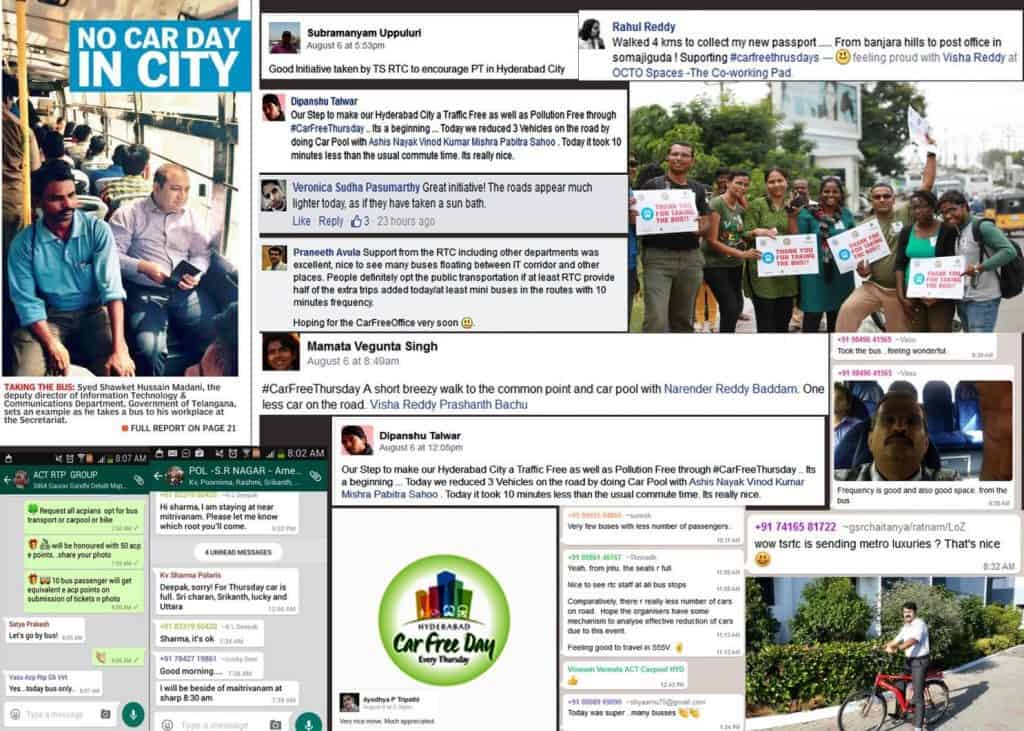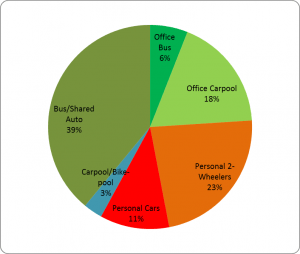The extreme spells of rain over the past few weeks may have made Hyderabad’s traffic situation worse than ever, but the situation is hardly bearable even when we have less inclement weather. The problem is especially acute in the Hitech-City – Financial District area, given the large concentration of office goers who come here from various parts of the city. Traffic speeds on a regular day often fall to 12-15 km/hour, which is slower than riding a bicycle.
The current trend also suggests that more and more employees are switching from public transport towards owning and traveling by their personal vehicles – both due to increase in economic status and also easy availability of financing options. This has also resulted in many companies facing challenges with parking, as more single-occupancy vehicles flood office parks.
No infrastructure of any kind can cater to this increasing demand if people choose to travel by their personal vehicles. The city has already seen at least four flyovers/underpasses built in the area in the past five years, only to find ourselves stuck on them. Further, any infrastructure changes will take years to complete – nothing that can solve our suffering today!
What, then, could bring respite?
Four years ago, in 2015, people working in the Hitech City – Financial District cluster came together to participate in an experiment. They left their personal vehicles behind once a week – voluntarily! The experience and the impact of Car-Free Thursdays were phenomenal, even with the small shift of an estimated 10,000 people to buses, carpooling, cycling and even walking for workplace commutes.
Now in 2019, the magnitude of the problem is much larger and such voluntary actions may fall short in creating a similar impact. Yet, there exists an opportunity to do the same either if individual companies voluntarily decide to enforce a partial car-free day once a week, or if the city administration chooses to administer the same across the entire area.
How people commute
A sample survey of the travel patterns of people working in the IT cluster indicates that a significant 45% employees already use public transport. Another 21% engage in some form of carpooling. The entire traffic congestion that manifests on the roads is thus a result of just about 34% of people traveling by personal vehicles.
In total, the IT cluster experiences about 4 lakh vehicles each day (not including through traffic).
The above, in aggregate, clearly points to two things: one, how bad things can get if the rest of the people also start using personal vehicles for travel. Second, any intervention to restrict personal vehicles affects only 34%, while benefitting all. This warrants at least an experiment in affirmative action to reduce vehicular travel demand as a path towards lesser traffic congestion!
The solution: Car Free Thursdays 2.0
A real and immediate way to solve traffic congestion is to reduce the number of vehicles on the roads. Though this solution involves personal sacrifice or placing restrictions on personal vehicle usage, the benefits far out-weigh the adjustments that need to be made. More importantly, the benefits are immediate, for everyone to see!
Car Free Thursday 2.0 – with the rule extending to all forms of motorized personal vehicles including two-wheelers – can be an experiment that is run for a month, by the zonal administration, supporting an odd-even rule in partnership with companies and tech parks in the area. This can be enforced by the security in-charge at the entrance of the office premises, thus making any other logistical arrangement unnecessary.
A complete car-free-day would have a phenomenal impact, but such an exercise would call for provision of some alternative means of transport. However, in case of implementing the odd-even rule, essentially just 17% of the people who currently come alone in their personal vehicles get affected once a week – thereby prompting them to explore pairing with their other friends and colleagues to carpool/bike-pool, if not switch to public transport or cycling.
The results from this one month (four Thursdays) can guide the strategy in the short and medium terms. Moreover, this experiment also has the potential to enable a more permanent behavioural change among commuters in terms of their commuting choices.
Would it really make a difference?
By shifting the travel patterns of about 175,000 persons (35% of commuters in the Hitech City area) twice in a month, this initiative could have a tremendous impact on roads and traffic.
For one thing, traffic on the roads is expected to fall by nearly 30%, ensuring easier management and also reducing peak air pollution levels in the area will reduce by 50% or more.
Talking to a sample of people, one gauges the average distance travelled in the IT corridor to be about 14-15 km each way, which takes more than an hour. On car free days, the peak hour speeds could touch 20 kmph (a 30% reduction in congestion can theoretically double travel speeds), leading to a 15-minute saving in travel time per journey. Incidentally, this is also what we gathered anecdotally when we analysed the first run of Car Free Thursdays in 2015.

Reactions from commuters following Car Free Thursdays in Hyderabad in 2015. Pic: Car Free Thursdays Vision Document (By GearChange)
Sceptics often question the effectiveness of going car-free in the absence of more robust and reliable public transport. The fact is that bus reliability can actually improve on car free days, due to less congested roads and faster speeds, and can enable a shift of habit to public transport. Even the Hyderabad Metro will get a boost in ridership. Today, even those who live within a kilometre of a metro station are loathe to give up the easy luxury of their private vehicles. But with the odd-even norm, some would definitely give it a try.
Carpooling certainly affords a better social life and reduced stress, which may give further impetus to adoption on a regular basis. Even companies, grappling with parking space shortage, can relax on car free days. The multitude of benefits to individuals, companies, the city and the environment make it an experiment worth trying, at a time when the city’s mobility is under severe stress.


